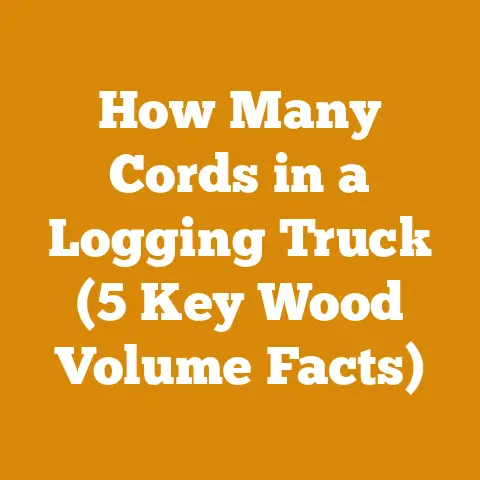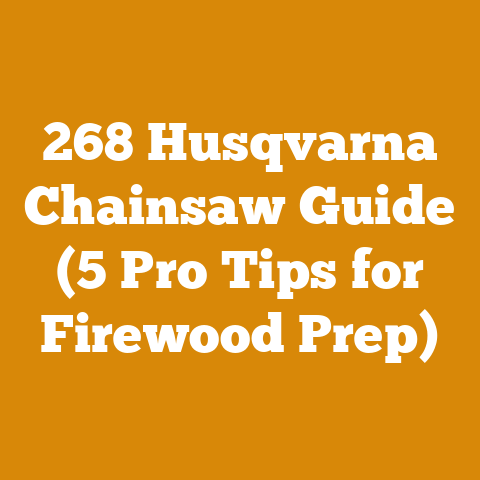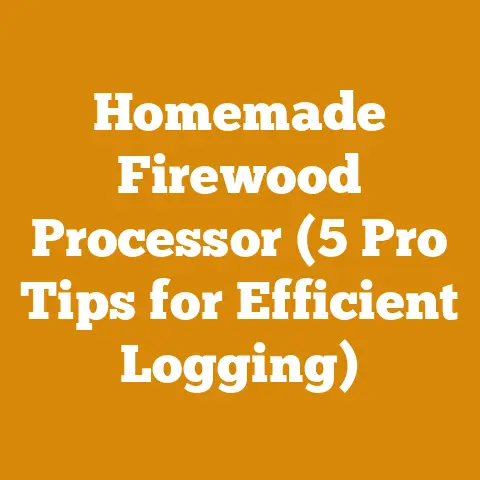How To Sell Used Chainsaws?
Have you ever wondered how much your used chainsaw is really worth, or how to connect with buyers who appreciate its value?
I’ve spent years working with chainsaws, not just using them in the field but also buying, selling, and maintaining them.
The market for used tools, including chainsaws, is surprisingly robust.
People are always looking for reliable equipment at a reasonable price.
Selling your used chainsaw can be a great way to declutter your shed, make some extra money, and even contribute to sustainability by giving your trusted tool a second life.
In this guide, I’ll share my strategies, tips, and insights on selling used chainsaws effectively, drawn from my own experiences and observations in the industry.
Understanding the Chainsaw Market
The used chainsaw market is dynamic, influenced by various economic and seasonal factors.
Understanding these trends can significantly impact your selling strategy.
I’ve seen firsthand how a little knowledge can make a big difference in how quickly and profitably you sell your equipment.
Market Trends for Used Chainsaws
Several factors drive the demand for used chainsaws.
Economic conditions play a significant role.
During economic downturns, people often opt for used tools to save money.
DIY trends also fuel demand, as homeowners take on more landscaping and woodworking projects themselves.
I remember during the 2008 recession, the demand for used chainsaws skyrocketed as people turned to home improvement projects to save money.
Seasonality is another crucial factor.
Demand typically peaks in the fall and winter as people prepare for firewood season and winter storms.
Landscaping businesses also ramp up their equipment inventories in the spring.
Keep an eye on these seasonal shifts to time your sale for maximum impact.
Popular Brands and Models
Certain brands and models consistently perform well in the used market.
Stihl and Husqvarna are generally the most sought-after brands, known for their durability and reliability.
Models like the Stihl MS 271 Farm Boss and the Husqvarna 455 Rancher are particularly popular among homeowners and semi-professional users.
I’ve noticed that these models hold their value well due to their reputation for performance and longevity.
Smaller, lighter models like the Stihl MS 170 and Husqvarna 135 are also popular, especially among casual users who need a chainsaw for occasional tasks.
Knowing which models are in demand can help you price your chainsaw competitively and attract the right buyers.
Types of Chainsaws and Their Demand
The type of chainsaw also affects its demand.
Gas-powered chainsaws are still the most popular due to their power and portability.
However, electric and battery-operated chainsaws are gaining traction, especially among environmentally conscious buyers and those who prefer quieter operation.
Gas-powered chainsaws are ideal for heavy-duty tasks like felling trees and cutting large logs.
Electric chainsaws are better suited for lighter tasks, such as pruning and trimming.
Battery-operated chainsaws offer a good balance of power and convenience, making them popular for a variety of tasks.
When selling, be sure to highlight the specific advantages of your chainsaw type to attract the right buyers.
Takeaway: Understanding the current market trends, popular brands, and the demand for different types of chainsaws is crucial for a successful sale.
Keep an eye on seasonal shifts and economic conditions to optimize your selling strategy.
Preparing Your Used Chainsaw for Sale
Proper preparation is key to maximizing the value of your used chainsaw.
A clean, well-maintained chainsaw not only looks more appealing but also inspires confidence in potential buyers.
I’ve learned that spending a little time on preparation can significantly increase your chances of a quick and profitable sale.
Cleaning the Chainsaw
The first step is to thoroughly clean the chainsaw.
Start by removing any loose dirt, sap, and sawdust with a brush or compressed air.
Pay special attention to the bar, chain, and engine housing.
I use a degreaser to remove stubborn grease and grime, being careful to avoid getting it on any rubber or plastic parts.
Next, clean the air filter.
A clogged air filter can reduce engine performance and make the chainsaw difficult to start.
Remove the air filter and clean it with warm, soapy water.
Allow it to dry completely before reinstalling it.
I’ve found that a clean air filter can make a noticeable difference in how the chainsaw runs, which is a major selling point.
Finally, clean the spark plug.
A dirty or worn spark plug can also affect engine performance.
Remove the spark plug and clean it with a wire brush.
If the spark plug is heavily worn or damaged, replace it with a new one.
A new spark plug is a cheap and easy way to improve the chainsaw’s performance.
Performing Basic Maintenance
Basic maintenance is essential to ensure the chainsaw is in good working condition.
Start by sharpening the chain.
A sharp chain cuts faster and more efficiently, making the chainsaw easier to use.
I use a chainsaw file to sharpen the chain, following the manufacturer’s instructions.
If you’re not comfortable sharpening the chain yourself, you can take it to a professional.
Next, check the oil levels.
Make sure the chain oil reservoir is full and that the chain oiler is working properly.
A properly lubricated chain will last longer and cut more efficiently.
I also check the engine oil level and add oil as needed.
Low engine oil can cause serious damage to the engine.
Finally, inspect all parts for wear and tear.
Check the bar for damage, such as bends or cracks.
Replace the bar if necessary.
Also, check the chain for worn or damaged links.
Replace the chain if necessary.
I’ve found that replacing worn parts can significantly increase the chainsaw’s value and appeal.
Documenting Condition
Accurate documentation of the chainsaw’s condition is crucial for building trust with potential buyers.
Take high-quality photos from various angles, highlighting both the good and the bad.
Be honest about any scratches, dents, or other cosmetic imperfections.
I always include photos of the engine, bar, and chain to give buyers a clear picture of the chainsaw’s condition.
Write a detailed description of the chainsaw’s condition, including its age, usage history, and any known issues.
Be upfront about any repairs or modifications that have been made.
I also include information about the chainsaw’s performance, such as how well it starts, how smoothly it runs, and how efficiently it cuts.
Takeaway: Thoroughly cleaning the chainsaw, performing basic maintenance, and accurately documenting its condition are essential steps in preparing it for sale.
This will not only increase its value but also build trust with potential buyers.
Valuing Your Chainsaw
Determining the fair market value of your used chainsaw is a critical step in the selling process.
Price it too high, and you risk scaring away potential buyers.
Price it too low, and you’ll leave money on the table.
I’ve learned that a little research and careful consideration can help you strike the right balance.
Researching Similar Listings Online
The best way to determine the fair market value of your used chainsaw is to research similar listings online.
Check sites like eBay, Craigslist, and specialty tool resale sites to see what other people are asking for similar models in similar condition.
Pay attention to the selling prices, not just the asking prices.
I always look for listings that have actually sold, as this gives me a more accurate idea of what buyers are willing to pay.
When comparing listings, be sure to consider the condition of the chainsaw, its age, and any included accessories.
A chainsaw in excellent condition with a new bar and chain will likely fetch a higher price than a chainsaw in poor condition with a worn bar and chain.
I also look for listings that include original manuals, cases, and other accessories, as these can add value.
Factors Influencing Price
Several factors can influence the price of your used chainsaw.
Brand reputation is a major factor.
As I mentioned earlier, Stihl and Husqvarna chainsaws generally command higher prices due to their reputation for quality and durability.
Model popularity is another factor.
Certain models, like the Stihl MS 271 Farm Boss and Husqvarna 455 Rancher, are in high demand and tend to hold their value well.
Condition is perhaps the most important factor.
A chainsaw in excellent condition with low hours will likely fetch a higher price than a chainsaw in poor condition with high hours.
Included accessories can also influence the price.
A chainsaw that comes with a case, extra chains, and other accessories will likely be worth more than a chainsaw that comes with nothing else.
I’ve found that even small accessories, like a chain sharpening kit, can add value.
Setting a Competitive Price
Setting a competitive price is crucial for attracting buyers and ensuring a fair return.
Start by researching similar listings online and considering the factors that influence price.
Then, set a price that is slightly below the average selling price for similar models in similar condition.
This will make your chainsaw more attractive to buyers and increase your chances of a quick sale.
Be prepared to negotiate.
Many buyers will try to negotiate the price down, so it’s important to have a bottom line in mind.
I usually set my initial price slightly higher than my bottom line to give myself some room to negotiate.
Also, be willing to offer discounts for cash or for buyers who are willing to pick up the chainsaw in person.
Takeaway: Researching similar listings, considering the factors that influence price, and setting a competitive price are essential for maximizing your return on your used chainsaw.
Be prepared to negotiate and offer discounts to attract buyers.
Choosing the Right Selling Platform
Selecting the right selling platform can significantly impact your success in selling your used chainsaw.
Each platform has its own advantages and disadvantages, including audience reach, ease of use, and potential fees.
I’ve experimented with various platforms over the years and have found that the best choice depends on your specific needs and goals.
Online Marketplaces
Online marketplaces like eBay, Facebook Marketplace, and Craigslist are popular options for selling used chainsaws.
eBay offers a large audience and a structured selling process, but it also charges fees.
Facebook Marketplace is free to use and allows you to connect with local buyers, but it can be less secure.
Craigslist is also free to use and allows you to connect with local buyers, but it has a reputation for attracting scammers.
I’ve had success selling chainsaws on all three platforms.
eBay is great for reaching a wide audience and getting a fair price, but the fees can eat into your profits.
Facebook Marketplace is good for selling locally and avoiding fees, but you need to be careful about meeting strangers.
Craigslist is a good option if you’re selling a less expensive chainsaw and don’t want to deal with fees, but you need to be extra cautious about safety.
Local Classifieds and Bulletins
Local classifieds and bulletins can be a good option for selling used chainsaws to local buyers.
These platforms are often free to use and allow you to connect with people in your community.
However, they typically have a smaller audience than online marketplaces.
I’ve used local classifieds to sell chainsaws to neighbors and friends.
It’s a convenient way to sell locally and avoid shipping costs.
Specialty Websites for Tools and Equipment
Specialty websites for tools and equipment can be a good option for selling used chainsaws to a targeted audience.
These websites often cater to professionals and serious DIYers who are willing to pay more for quality tools.
However, they may charge fees or require you to meet certain criteria to list your chainsaw.
I’ve considered using specialty websites to sell high-end chainsaws, but I haven’t yet found one that I’m comfortable with.
Consignment Shops and Pawn Shops
Consignment shops and pawn shops can be a convenient option for selling used chainsaws, but they typically offer lower prices than other platforms.
Consignment shops will sell your chainsaw on your behalf and take a percentage of the sale price.
Pawn shops will buy your chainsaw outright, but they will typically offer you a low price.
I’ve used pawn shops as a last resort when I needed to sell a chainsaw quickly and didn’t want to deal with the hassle of selling it myself.
Takeaway: Choosing the right selling platform depends on your specific needs and goals.
Consider the audience reach, ease of use, and potential fees of each platform before making a decision.
Crafting an Effective Listing
A well-crafted listing is essential for attracting potential buyers and maximizing your chances of a successful sale.
Your listing should be clear, concise, and informative, highlighting the key features and benefits of your used chainsaw.
I’ve learned that spending a little time on your listing can make a big difference in how quickly and profitably you sell your equipment.
Writing an Engaging Title
Your title is the first thing that potential buyers will see, so it’s important to make it engaging and informative.
Include the brand, model, and condition of the chainsaw in your title.
For example, “Stihl MS 271 Farm Boss – Excellent Condition” is a good title.
I also try to include keywords that buyers are likely to search for, such as “used chainsaw” or “gas-powered chainsaw.”
Structuring the Description
Your description should provide a detailed overview of the chainsaw, including its key features, specifications, and condition.
Start by highlighting the brand and model of the chainsaw, as well as its age and usage history.
Then, describe its condition in detail, including any scratches, dents, or other cosmetic imperfections.
Be honest and transparent about any known issues.
Include technical specifications such as engine size (e.g., 50.2 cc), bar length (e.g., 18 inches), and weight (e.g., 12.3 lbs).
This information helps potential buyers assess whether the chainsaw meets their specific needs.
I also mention any included accessories, such as a case, extra chains, or a chain sharpening kit.
Emphasizing Unique Selling Points
Highlight any unique selling points that make your chainsaw stand out from the competition.
For example, if the chainsaw has low hours, emphasize that in your description.
If it comes with a new bar and chain, be sure to mention that as well.
I also highlight any repairs or modifications that have been made, especially if they improve the chainsaw’s performance or reliability.
Using High-Quality Images
High-quality images are essential for attracting potential buyers.
Take clear, well-lit photos of the chainsaw from various angles, highlighting both the good and the bad.
Be sure to include close-up photos of the engine, bar, and chain.
I also include photos of any accessories that are included with the chainsaw.
Optimizing Listings for Searchability
Optimize your listing for searchability by using relevant keywords and tags.
Think about what buyers are likely to search for when looking for a used chainsaw, and include those keywords in your title and description.
For example, “used chainsaw,” “gas-powered chainsaw,” “Stihl chainsaw,” and “Husqvarna chainsaw” are all good keywords to include.
I also use tags to further categorize my listing and make it easier for buyers to find.
Takeaway: Crafting an effective listing is crucial for attracting potential buyers and maximizing your chances of a successful sale.
Write an engaging title, structure your description effectively, emphasize unique selling points, use high-quality images, and optimize your listing for searchability.
Engaging with Potential Buyers
Effective communication with potential buyers is crucial for building trust and closing the sale.
Responding promptly and professionally to inquiries, being transparent about the chainsaw’s condition, and negotiating the price fairly are all essential skills.
I’ve learned that good communication can often make the difference between a successful sale and a missed opportunity.
Responding to Inquiries Promptly and Professionally
Respond to inquiries promptly and professionally.
Potential buyers are more likely to lose interest if you take too long to respond.
I try to respond to inquiries within a few hours, even if it’s just to acknowledge that I’ve received the message and will get back to them with more information later.
Use proper grammar and spelling in your responses, and avoid using slang or abbreviations.
Being Transparent About the Chainsaw’s Condition
Be transparent about the chainsaw’s condition and history.
Answer any questions honestly and thoroughly.
If there are any known issues with the chainsaw, disclose them upfront.
I always provide potential buyers with as much information as possible, including photos, videos, and documentation.
Negotiating Price Fairly
Be prepared to negotiate the price, but don’t undervalue your item.
Know your bottom line and be willing to walk away if the buyer isn’t willing to pay a fair price.
I usually start by asking for slightly more than my bottom line, to give myself some room to negotiate.
Be polite and respectful during negotiations, and avoid getting emotional or defensive.
Building Trust with Potential Buyers
Building trust with potential buyers is essential for closing the sale.
Be honest, transparent, and responsive.
Provide as much information as possible, and answer any questions thoroughly.
Offer to meet in person to show the chainsaw to potential buyers.
I also offer a guarantee or warranty, if possible.
A guarantee or warranty can give buyers peace of mind and increase their confidence in the purchase.
Takeaway: Engaging effectively with potential buyers is crucial for building trust and closing the sale.
Respond promptly and professionally to inquiries, be transparent about the chainsaw’s condition, negotiate the price fairly, and build trust with potential buyers.
Closing the Sale
Finalizing the sale involves several key steps, including arranging payment methods, discussing safe meeting locations for in-person transactions, and providing a receipt or bill of sale if necessary.
I’ve learned that attention to detail during this stage can ensure a smooth and positive experience for both buyer and seller.
Arranging Payment Methods
Arrange payment methods that are convenient and secure for both you and the buyer.
Cash is a common option for in-person transactions, but it can be risky.
Electronic payments through platforms like PayPal or Venmo are more secure, but they may involve fees.
I prefer to use electronic payments whenever possible, as they provide a record of the transaction and offer some protection against fraud.
Discussing Safe Meeting Locations
Discuss safe meeting locations for in-person transactions.
Choose a public place with good lighting and security cameras.
Avoid meeting at your home or in a secluded area.
I often meet buyers at a local police station or a busy shopping center.
Bring a friend or family member with you for added safety.
Providing a Receipt or Bill of Sale
Provide a receipt or bill of sale to the buyer.
The receipt should include the date of the sale, the price of the chainsaw, and a description of the chainsaw.
The bill of sale should also include the names and addresses of the buyer and seller.
I always keep a copy of the receipt or bill of sale for my records.
Importance of Customer Service
Good customer service doesn’t end with the sale.
Follow up with the buyer after the sale to ensure they are satisfied with the chainsaw.
Offer to answer any questions they may have or provide assistance with troubleshooting.
A positive customer experience can lead to repeat business and referrals.
I’ve had customers come back to me years later to buy more equipment, simply because they were happy with their initial purchase.
Takeaway: Closing the sale involves arranging payment methods, discussing safe meeting locations, providing a receipt or bill of sale, and following up with the buyer after the sale.
Attention to detail during this stage can ensure a smooth and positive experience for both buyer and seller.
Conclusion
Selling used chainsaws can be a rewarding endeavor, both financially and environmentally.
By understanding the market, preparing your chainsaw properly, valuing it accurately, choosing the right selling platform, crafting an effective listing, engaging with potential buyers, and closing the sale effectively, you can maximize your chances of success.
Remember, the key to success is to be honest, transparent, and responsive.
Provide potential buyers with as much information as possible, answer any questions thoroughly, and offer a guarantee or warranty if possible.
So, whether you’re looking to declutter your shed, make some extra money, or contribute to sustainability, I encourage you to take action.
Clean your chainsaw, research its value, and list it for sale.
You might be surprised at how much your used chainsaw is really worth.






